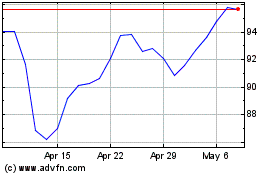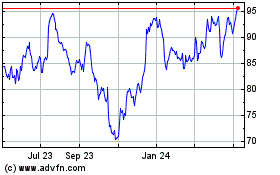Morgan Stanley Toughens Pay Hurdles for Brokers
December 02 2016 - 6:10PM
Dow Jones News
Some Morgan Stanley brokers will see pay cuts next year unless
they boost the fees and commissions they collect, a move that comes
as part of the bank's broader efforts to rein in costs.
Starting in January, Morgan Stanley will raise some
compensation-grid thresholds it uses to pay brokers by about 10% to
incentivize them to produce more revenue, a person with knowledge
of the matter said. The vast majority of a broker's pay is based on
the amount of fees and commissions they bring in each year, with
bigger producers keeping a larger percentage of the revenue they
generate.
Morgan Stanley Chief Executive James Gorman has been pushing the
entire bank to cut $1 billion in annual costs through an initiative
dubbed "Project Streamline" that was started earlier this year. In
wealth management specifically, Mr. Gorman wants to tamp down how
much it spends on broker pay, which can reach seven figures for top
brokers.
Many of Morgan Stanley's more than 15,000 brokers won't see any
substantial change to their pay next year under the plan. However,
those who fall on the edges of the grid's thresholds will have to
generate more revenue to hit the higher hurdles.
A broker who generates $220,000 next year, for example, will get
paid 28% of that revenue under the 2017 compensation plan, the
lowest hurdle. This year, $220,000 in revenue would have netted the
same broker a 32% payout. If the broker wants to maintain his 32%
payout in 2017, he would need to produce an additional $22,000 in
fees and commissions.
Bigger producers will be affected, too. Brokers aiming for 49%
to 53% revenue payouts will need to generate at least $3.3 million
in fees and commissions next year, up from $3 million in 2016. The
grid's biggest hurdle, 51.5% to 55.5%, which depends on the
broker's length of service, remains unchanged at $5 million.
The move is similar to changes enacted by Bank of America's
Merrill Lynch this year. Some Merrill brokers saw their base pay
fall by 2% to 8% in 2016 unless they produced more revenue to hit
higher hurdles.
Morgan Stanley will continue to offer bonuses to brokers who
sell debt products such as securities-backed loans and mortgages,
as well as for getting clients to use banking products—two
incentives the bank is using to increase its loans and
deposits.
UBS Group AG is the only other major bank to detail its broker
compensation plans for 2017 so far. The Swiss bank in June
introduced a simplified pay plan for its U.S. brokers that
increased cash payouts mostly for teams that generate $1 million or
more in revenue, while dropping the number of deferred bonuses they
can earn to focus specifically on length of service and new assets
gained.
UBS brokers are expected to generally receive more cash under
the compensation plan next year, executives at the firm previously
told The Wall Street Journal. The firm pulled back from recruiting
and eliminated some middle-management and support staff to cover
the higher compensation costs.
AdvisorHub earlier reported Morgan Stanley's compensation
plans.
Write to Michael Wursthorn at Michael.Wursthorn@wsj.com
(END) Dow Jones Newswires
December 02, 2016 17:55 ET (22:55 GMT)
Copyright (c) 2016 Dow Jones & Company, Inc.
Morgan Stanley (NYSE:MS)
Historical Stock Chart
From Mar 2024 to Apr 2024

Morgan Stanley (NYSE:MS)
Historical Stock Chart
From Apr 2023 to Apr 2024
